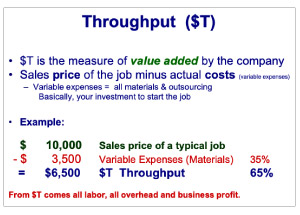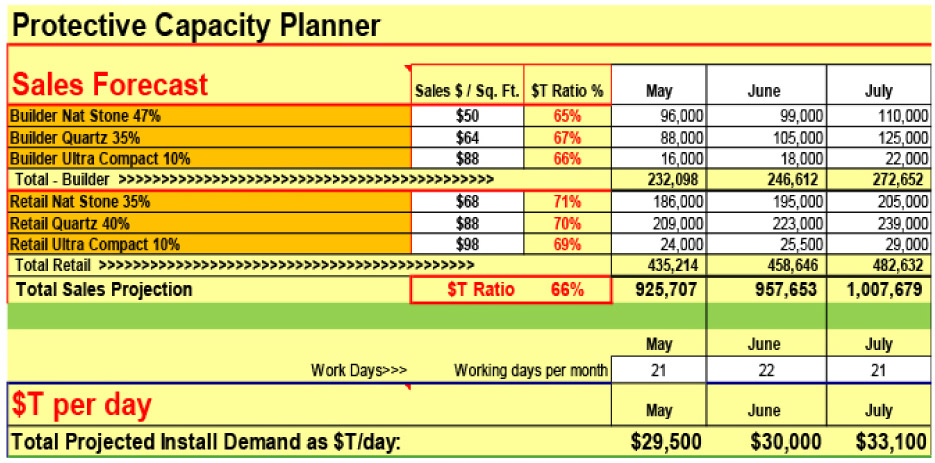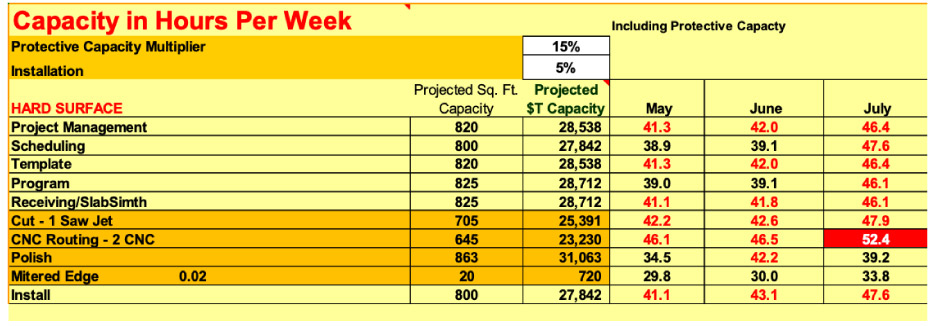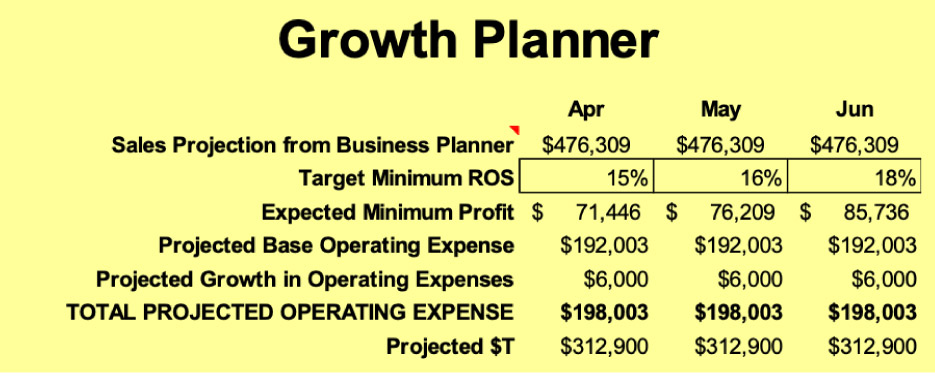Capacity Planning in 2022
Ed Hill
Synchronous Solutions
This time last year, most fabricators were in the midst of a major tsunami. We expected it, some planned for it, and others suffered through it. The pent-up demand was enormous, then vaccines became available to provide some security against the terrible pandemic, and business was booming. Most companies experienced a dramatically increased volume of sales. We saw business growth of 25 to 50 percent in many cases.
Then we ran into new problems. It became extremely difficult to attract and retain enough employees to maintain existing demand, much less enough to add capacity to accommodate significant growth. The virus did not subside as we had hoped, and employee absences became a serious threat to productivity.
The supply chain issues have impacted our business, too. Some slabs and sinks are unavailable or slow to arrive. Customers who ordered new cabinets are delayed for weeks or even months. Our challenging business has become even more challenging.
More than ever before, sufficient planning is the key to success.
There are three types of capacity that should be in your planning routine:
- Productive Capacity
– The minimum required to get the job done. Given the uncertainty of demand and availability of capacity resources, it is important to plan for various scenarios. A robust tool is needed rather than just “gut instinct.”
- Protective Capacity
– Capacity to absorb variability. This is the minimum capacity plus about 15 percent more at non-constraints to accommodate the inevitable attacks by Murphy. Protective capacity is more important than ever given the uncertainties we face.
- Excess Capacity
– Too much capacity at any resource step is wasteful. If any resource demonstrates more than about 15 percent Protective Capacity over the absorption of variability, that is excessive and uneconomical.
Productive Capacity
The minimum capacity needed at each process step is called Productive Capacity. It is fairly easy to calculate by comparing the demonstrated productivity at each process step to the needed square feet, per day. However, as we all know, “Murphy Lives,” meaning that you must have some additional capacity over the minimum to accommodate the inevitable issues that will occur every day, such as:
- Staffing issues. Absenteeism, turnover, vacations, training, etc.
- Equipment issues. Machine downtime, tooling availability, etc.
- Material issues. Poor quality, erratic delivery from vendors, etc.
- Weather issues.
- Coronavirus issues.
- Etcetera, etcetera…
It is a fact that if you only plan for the minimum capacity, you will always struggle to meet the market demand. That approach can result in excessive overtime, potential quality problems, employee burnout and extreme chaos throughout the business process.
Protective Capacity
Therefore, given the reality of Murphy, it is important to establish and maintain Protective Capacity throughout the operations system. Protective Capacity is essential for a smooth and predictable process flow. Maintaining Protective Capacity at all times allows you to:
- Achieve and maintain short cycle times.
- Absorb the daily attacks by Murphy without affecting the install schedule.
- Finitely schedule the Control Point (Install) with assurance that the schedule can be met.
- Bring stability and calmness into the business system.
- Confidently sell because there is knowledge that manufacturing can meet the demand.
Note that Protective Capacity is not an additional cost issue. In fact, it will save you money and, more importantly, it will allow you to create more $T value with less need for overtime, stress and chaos in busy times.
Planning for Growth
The Protective Capacity Planner (PCP) is the tool to use in planning for profitable growth. This tool will tell you when to take certain actions to keep three important business metrics in alignment: (1) the projected market demand; (2) the needed manufacturing capacity to meet that demand; (3) and your resulting financial goals. This report will show you the current status of each. It will allow you to do a “what if” analysis to check the effects of any demand projection and any operational action. It is the “long-term planning tool” for your business. It is the essence of planning using the Synchronous Flow business system.
The example below is a portion of the PCP indicating the sales projections by product and market segment. Only the white cells require data entry and should be updated monthly to assure current information is posted.
 The system then calculates the daily Throughput ($T) required to be scheduled in order to meet the demand. We use $T rather than square feet or any other dimensional metric, because it is more reflective of the actual labor content, and it is directly related to the company financial goals.
The system then calculates the daily Throughput ($T) required to be scheduled in order to meet the demand. We use $T rather than square feet or any other dimensional metric, because it is more reflective of the actual labor content, and it is directly related to the company financial goals.
The system then calculates the daily Throughput ($T) required to be scheduled to meet the demand. We use $T rather than square feet or any other dimensional metric, because it is more reflective of the actual labor content, and it is directly related to the company financial goals. The sales dollars per square feet is used to convert dimensional capacity estimates to Throughput dollars ($T), which is then compared to the daily $T demand.
Using the current equipment and staffing in the company, the system automatically calculates the needed hours per week at each resource step to meet the posted market demand.
As in the Capacity in Hours Per Week chart (below), the system shows black font when the calculation is at 40 hours or less, red font when the indication is that some overtime will be required, and red fill when the overtime required is excessive (over 48 hours per week).
The Protective Capacity Multiplier is used to allow for the needed additional capacity at each resource step to accommodate the inevitable interruptions due to statistical fluctuations (aka attacks by Murphy).
 |
|
Above: In this PCP example, only the white cells require data entry and should be updated monthly to assure current information is posted.
|
 |
Financial Goals
Given the demand picture and the desired return on those sales, the Protective Capacity Planning tool will calculate the expected net profit and the maximum operating expense (all labor and all overhead) that can be experienced in order to make that profit amount at the given level of sales. In effect, this becomes the expense budget for each of the coming months. The financial officer of the company can divide that maximum operating expense into a fixed and variable budget. Usually, the variable budget boils down to labor and supplies and can form the expenditure targets for operations management. Controlling labor (including overtime) and supplies to this level while meeting the market demand will help to assure that the company’s financial goals can be met.
 |
|
The Growth Planner gives you the bottom-line status of the financial condition of your business system, and indicates decisions needed to maximize financial profits. |
Taking this to the next logical step, the system evolves to a monthly Dynamic Budget (aka Expense Control Planner) which uses the current sales revenue projections to automatically post to a line-item financial status of the business system. The conclusion of this analysis indicates the prevailing Status to the Controllable Expense (CE) Limit. This leads to a clear indication of the actions that are needed to maximize financial profits.
Kept up to date and used effectively, the Protective Capacity Planner can become a very important element of your routine business management. It will trigger actions to generate sales when the demand is low and it will trigger actions to prepare the needed capacity when demand is high. It is the tool to coordinate market demand, manufacturing capacity and your financial goals.
For more information on how to effectively plan for the needed capacity, contact Ed Hill, Synchronous Solutions, LLC, 704-560-1536. Visit www.SynchronousSolutions.com for more information on the their programs.